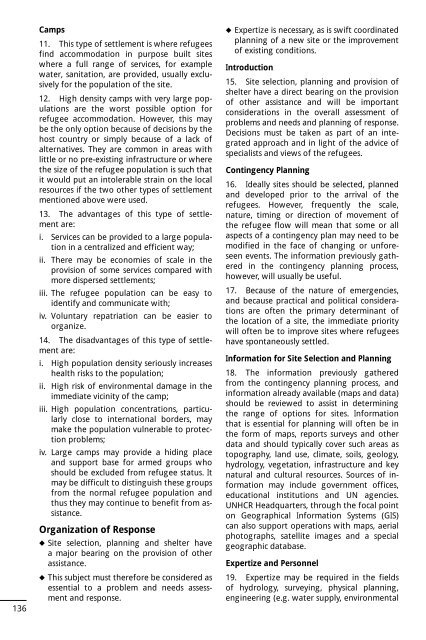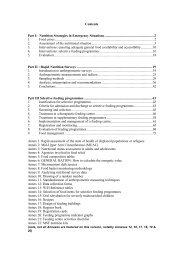UNHCR Handbook for Emergencies - UNHCR eCentre
UNHCR Handbook for Emergencies - UNHCR eCentre
UNHCR Handbook for Emergencies - UNHCR eCentre
You also want an ePaper? Increase the reach of your titles
YUMPU automatically turns print PDFs into web optimized ePapers that Google loves.
136<br />
Camps<br />
11. This type of settlement is where refugees<br />
find accommodation in purpose built sites<br />
where a full range of services, <strong>for</strong> example<br />
water, sanitation, are provided, usually exclusively<br />
<strong>for</strong> the population of the site.<br />
12. High density camps with very large populations<br />
are the worst possible option <strong>for</strong><br />
refugee accommodation. However, this may<br />
be the only option because of decisions by the<br />
host country or simply because of a lack of<br />
alternatives. They are common in areas with<br />
little or no pre-existing infrastructure or where<br />
the size of the refugee population is such that<br />
it would put an intolerable strain on the local<br />
resources if the two other types of settlement<br />
mentioned above were used.<br />
13. The advantages of this type of settlement<br />
are:<br />
i. Services can be provided to a large population<br />
in a centralized and efficient way;<br />
ii. There may be economies of scale in the<br />
provision of some services compared with<br />
more dispersed settlements;<br />
iii. The refugee population can be easy to<br />
identify and communicate with;<br />
iv. Voluntary repatriation can be easier to<br />
organize.<br />
14. The disadvantages of this type of settlement<br />
are:<br />
i. High population density seriously increases<br />
health risks to the population;<br />
ii. High risk of environmental damage in the<br />
immediate vicinity of the camp;<br />
iii. High population concentrations, particularly<br />
close to international borders, may<br />
make the population vulnerable to protection<br />
problems;<br />
iv. Large camps may provide a hiding place<br />
and support base <strong>for</strong> armed groups who<br />
should be excluded from refugee status. It<br />
may be difficult to distinguish these groups<br />
from the normal refugee population and<br />
thus they may continue to benefit from assistance.<br />
Organization of Response<br />
◆ Site selection, planning and shelter have<br />
a major bearing on the provision of other<br />
assistance.<br />
◆ This subject must there<strong>for</strong>e be considered as<br />
essential to a problem and needs assessment<br />
and response.<br />
◆ Expertize is necessary, as is swift coordinated<br />
planning of a new site or the improvement<br />
of existing conditions.<br />
Introduction<br />
15. Site selection, planning and provision of<br />
shelter have a direct bearing on the provision<br />
of other assistance and will be important<br />
considerations in the overall assessment of<br />
problems and needs and planning of response.<br />
Decisions must be taken as part of an integrated<br />
approach and in light of the advice of<br />
specialists and views of the refugees.<br />
Contingency Planning<br />
16. Ideally sites should be selected, planned<br />
and developed prior to the arrival of the<br />
refugees. However, frequently the scale,<br />
nature, timing or direction of movement of<br />
the refugee flow will mean that some or all<br />
aspects of a contingency plan may need to be<br />
modified in the face of changing or un<strong>for</strong>eseen<br />
events. The in<strong>for</strong>mation previously gathered<br />
in the contingency planning process,<br />
however, will usually be useful.<br />
17. Because of the nature of emergencies,<br />
and because practical and political considerations<br />
are often the primary determinant of<br />
the location of a site, the immediate priority<br />
will often be to improve sites where refugees<br />
have spontaneously settled.<br />
In<strong>for</strong>mation <strong>for</strong> Site Selection and Planning<br />
18. The in<strong>for</strong>mation previously gathered<br />
from the contingency planning process, and<br />
in<strong>for</strong>mation already available (maps and data)<br />
should be reviewed to assist in determining<br />
the range of options <strong>for</strong> sites. In<strong>for</strong>mation<br />
that is essential <strong>for</strong> planning will often be in<br />
the <strong>for</strong>m of maps, reports surveys and other<br />
data and should typically cover such areas as<br />
topography, land use, climate, soils, geology,<br />
hydrology, vegetation, infrastructure and key<br />
natural and cultural resources. Sources of in<strong>for</strong>mation<br />
may include government offices,<br />
educational institutions and UN agencies.<br />
<strong>UNHCR</strong> Headquarters, through the focal point<br />
on Geographical In<strong>for</strong>mation Systems (GIS)<br />
can also support operations with maps, aerial<br />
photographs, satellite images and a special<br />
geographic database.<br />
Expertize and Personnel<br />
19. Expertize may be required in the fields<br />
of hydrology, surveying, physical planning,<br />
engineering (e.g. water supply, environmental



